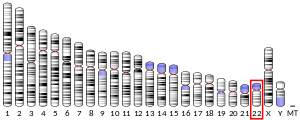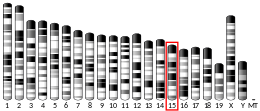Ku70
Ku70は、XRCC6遺伝子にコードされているタンパク質である[5][6]。
機能
編集Ku70はKu80とヘテロ二量体を形成して、DNA修復のための非相同末端結合(NHEJ)経路に必要なKu自己抗原となる。また、NHEJ経路を利用して哺乳類の免疫系の抗原多様性を増大させるV(D)J遺伝子再構成にも要求される。また、NHEJ経路が関与しない、テロメア長の維持とサブテロメア遺伝子サイレンシングにも不可欠な役割を果たす[7]。
Kuは、全身性エリテマトーデスの患者がタンパク質に対して高レベルの自己抗体を持っていることが判明したときに最初に同定された[5]。
老化との関連
編集ホモ接合型Ku70変異を持つマウス胚性幹細胞(Ku70 -/-細胞)において、ヘテロ接合型Ku70 +/-または野生型Ku70 + / +胚性幹細胞と比較して、電離放射線に対する感受性は著しく増加した[8]。Ku70を欠損した変異マウスは早期老化を示す[9]。いくつかの老化の基準に基づいて分析が行われたところ、変異マウスは対照マウスと同じ老化の兆候を示すが、そのときの年齢は対照マウスと比べて著しく早いことが判明した。これらの結果は、野生型Ku70遺伝子によるDNA二本鎖切断を修復する能力の低下が早期老化を引き起こし、この遺伝子が寿命の保証に重要な役割を果たしていることを示唆する[10]。
臨床
編集この遺伝子の突然変異については、自閉症の24家族のエクソーム解析の研究結果が記述されている[11]。これは、この遺伝子が自閉症の発症に関与している可能性があることを示唆しており、さらなる調査が期待されている。
別名
編集Ku70は、以下で記述するいくつかの別名でも呼ばれる。
- ループスKu自己抗原タンパク質p70(Lupus Ku autoantigen protein p70)
- ATP依存性DNAヘリカーゼ2サブユニット1(ATP-dependent DNA helicase 2 subunit 1)
- X-ray repair complementing defective repair in Chinese hamster cells 6
- X線修復交差補完タンパク質6(XRCC6: X-ray repair cross-complementing 6)
相互作用分子
編集Ku70は以下の生体分子と相互作用する。
脚注
編集- ^ a b c GRCh38: Ensembl release 89: ENSG00000196419 - Ensembl, May 2017
- ^ a b c GRCm38: Ensembl release 89: ENSMUSG00000022471 - Ensembl, May 2017
- ^ Human PubMed Reference:
- ^ Mouse PubMed Reference:
- ^ a b “Entrez Gene: XRCC6 X-ray repair complementing defective repair in Chinese hamster cells 6 (Ku autoantigen, 70kDa)”. アメリカ国立生物工学情報センター (2021年8月2日). 2021年8月7日閲覧。
- ^ Paul Pace, Georgina Mosedale, Michael Hodskinson, Ivan V. Rosado, Meera Sivasubramaniam and Ketan J. Patel (10 Jun 2010). “Ku70 corrupts DNA repair in the absence of the Fanconi anemia pathway”. Science 329 (5988): 219–23. doi:10.1126/science.1192277. PMID 20538911.
- ^ Simon J. Boulton, Stephen P. Jackson (16 March 1998). “Components of the Ku-dependent non-homologous end-joining pathway are involved in telomeric length maintenance and telomeric silencing”. The EMBO Journal 17 (6): 1819–28. doi:10.1093/emboj/17.6.1819. PMC 1170529. PMID 9501103.
- ^ Yansong Gu, Shengfang Jin, Yijie Gao, David T. Weaver, and Frederick W. Alt (July 22, 1997). “Ku70-deficient embryonic stem cells have increased ionizing radiosensitivity, defective DNA end-binding activity, and inability to support V(D)J recombination”. Proceedings of the National Academy of Sciences of the United States of America 94 (15): 8076–81. doi:10.1073/pnas.94.15.8076. PMC 21559. PMID 9223317.
- ^ Han Li, Hannes Vogel, Valerie B Holcomb, Yansong Gu, Paul Hasty (Dec 2007). “Deletion of Ku70, Ku80, or both causes early aging without substantially increased cancer”. Molecular and Cellular Biology 27 (23): 8205–14. doi:10.1128/MCB.00785-07. PMC 2169178. PMID 17875923.
- ^ Carol Bernstein, Harris Bernstein, Claire M Payne, Katerina Dvorak, Harinder Garewal (2008 Feb 18). “Field defects in progression to gastrointestinal tract cancers”. Cancer Letters 260 (1-2): 1-10. doi:10.1016/j.canlet.2007.11.027. PMC 2744582. PMID 18164807.
- ^ Calvin P Sjaarda, Shalandra Wood, Amy J M McNaughton, Sarah Taylor, Melissa L Hudson, Xudong Liu, Andrea Guerin, Muhammad Ayub (12 December 2019). “Exome sequencing identifies de novo splicing variant in XRCC6 in sporadic case of autism”. Journal of Human Genetics 65 (3): 287-296. doi:10.1038/s10038-019-0707-0. PMID 31827253.
- ^ “Human Ku70 interacts with heterochromatin protein 1alpha”. The Journal of Biological Chemistry 276 (11): 8321–7. (2001 Mar 16). doi:10.1074/jbc.M008779200. PMID 11112778.
- ^ “Regulatory interactions between the checkpoint kinase Chk1 and the proteins of the DNA-dependent protein kinase complex”. The Journal of Biological Chemistry 278 (32): 29940–7. (8 August 2003). doi:10.1074/jbc.M301765200. PMID 12756247.
- ^ a b c “Repression of GCN5 histone acetyltransferase activity via bromodomain-mediated binding and phosphorylation by the Ku-DNA-dependent protein kinase complex”. Molecular and Cellular Biology 18 (3): 1349–58. (Mar 1998). doi:10.1128/mcb.18.3.1349. PMC 108848. PMID 9488450.
- ^ “The binding of Ku antigen to homeodomain proteins promotes their phosphorylation by DNA-dependent protein kinase”. The Journal of Biological Chemistry 276 (20): 16848–56. (May 2001). doi:10.1074/jbc.M100768200. PMID 11279128.
- ^ “Mapping of protein-protein interactions within the DNA-dependent protein kinase complex”. Nucleic Acids Research 27 (17): 3494–502. (Sep 1999). doi:10.1093/nar/27.17.3494. PMC 148593. PMID 10446239.
- ^ “Isolation of Ku70-binding proteins (KUBs)”. Nucleic Acids Research 27 (10): 2165–74. (May 1999). doi:10.1093/nar/27.10.2165. PMC 148436. PMID 10219089.
- ^ “The C terminus of Ku80 activates the DNA-dependent protein kinase catalytic subunit”. Molecular and Cellular Biology 19 (5): 3267–77. (May 1999). doi:10.1128/mcb.19.5.3267. PMC 84121. PMID 10207052.
- ^ a b “Interaction of human Ku70 with TRF2”. FEBS Letters 481 (1): 81–5. (Sep 2000). doi:10.1016/S0014-5793(00)01958-X. PMID 10984620.
- ^ “Mre11 and Ku70 interact in somatic cells, but are differentially expressed in early meiosis”. Nature Genetics 23 (2): 194–8. (Oct 1999). doi:10.1038/13821. PMID 10508516.
- ^ “Thyroid hormone receptor-binding protein, an LXXLL motif-containing protein, functions as a general coactivator”. Proceedings of the National Academy of Sciences of the United States of America 97 (11): 6212–7. (May 2000). doi:10.1073/pnas.97.11.6212. PMC 18584. PMID 10823961.
- ^ “Nuclear receptor coactivator thyroid hormone receptor-binding protein (TRBP) interacts with and stimulates its associated DNA-dependent protein kinase”. The Journal of Biological Chemistry 278 (13): 11471–9. (Mar 2003). doi:10.1074/jbc.M209723200. PMID 12519782.
- ^ “The Ku70 autoantigen interacts with p40phox in B lymphocytes”. Journal of Cell Science 112 (4): 503–13. (Feb 1999). PMID 9914162.
- ^ “A proteomics approach to identify proliferating cell nuclear antigen (PCNA)-binding proteins in human cell lysates. Identification of the human CHL12/RFCs2-5 complex as a novel PCNA-binding protein”. The Journal of Biological Chemistry 277 (43): 40362–7. (Oct 2002). doi:10.1074/jbc.M206194200. PMID 12171929.
- ^ “Chromatin-bound PCNA complex formation triggered by DNA damage occurs independent of the ATM gene product in human cells”. Nucleic Acids Research 29 (6): 1341–51. (Mar 2001). doi:10.1093/nar/29.6.1341. PMC 29758. PMID 11239001.
- ^ “Human securin, hPTTG, is associated with Ku heterodimer, the regulatory subunit of the DNA-dependent protein kinase”. Nucleic Acids Research 29 (6): 1300–7. (Mar 2001). doi:10.1093/nar/29.6.1300. PMC 29753. PMID 11238996.
- ^ “Replication-mediated DNA damage by camptothecin induces phosphorylation of RPA by DNA-dependent protein kinase and dissociates RPA:DNA-PK complexes”. The EMBO Journal 18 (5): 1397–406. (Mar 1999). doi:10.1093/emboj/18.5.1397. PMC 1171229. PMID 10064605.
- ^ “Human Ku70/80 associates physically with telomerase through interaction with hTERT”. The Journal of Biological Chemistry 277 (49): 47242–7. (Dec 2002). doi:10.1074/jbc.M208542200. PMID 12377759.
- ^ “p95vav associates with the nuclear protein Ku-70”. Molecular and Cellular Biology 16 (1): 37–44. (Jan 1996). doi:10.1128/mcb.16.1.37. PMC 230976. PMID 8524317.
- ^ “Ku heterodimer binds to both ends of the Werner protein and functional interaction occurs at the Werner N-terminus”. Nucleic Acids Research 30 (16): 3583–91. (Aug 2002). doi:10.1093/nar/gkf482. PMC 134248. PMID 12177300.
- ^ “Functional interaction between Ku and the werner syndrome protein in DNA end processing”. The Journal of Biological Chemistry 275 (37): 28349–52. (Sep 2000). doi:10.1074/jbc.C000289200. PMID 10880505.
参考文献
編集- “The end-joining reaction in V(D)J recombination”. Seminars in Immunology 9 (3): 189–97. (Jun 1997). doi:10.1006/smim.1997.0070. PMID 9200330.
- “Ku, a DNA repair protein with multiple cellular functions?”. Mutation Research 434 (1): 3–15. (May 1999). doi:10.1016/s0921-8777(99)00006-3. PMID 10377944.
- “Dimerization, translocation and localization of Ku70 and Ku80 proteins”. Journal of Radiation Research 43 (3): 223–36. (Sep 2002). doi:10.1269/jrr.43.223. PMID 12518983.
外部リンク
編集- PDBe-KB:PDBで利用可能なヒトX線修復交差補完タンパク質6の構造情報を提供する。




